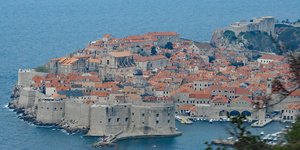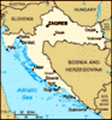Advertisement
Published: March 29th 2020

 Old Dubrovnik 12 - 17 century
Old Dubrovnik 12 - 17 century
Prosperous fortified medieval port cityOur full day tour of Dubrovnik was fascinating. For two hours, Jakica led us through the old city centre, combining facts with stories and personal memories. Most of the buildings that survived conquest, war and earthquakes are from about the sixth century, the fourteenth century, and the eighteenth century, plus twenty-first century new builds. Many of the historic buildings were damaged, some severely, in the early battles of the war with
Serbia and Montenegro 1991-1994. Almost everything has been restored, which makes the buildings look fresh and well-maintained. Jakica pointed out that the whiter limestone blocks are newer, because they come from a different quarry than the traditional blocks, and that the redder clay roof tiles are new, in contrast to the yellower old ones.
Two rival theories explain the origins of Dubrovnik and the Croatians. A Roman village existed at the foot of the hills, and the mountain-dwelling Croats settled on the hills; gradually the two towns made common cause and joined to become Dubrovnik. Relatively recently, excavations revealed even earlier peoples had settled in the area. Thus, no one knows. Later Venetian influence is obvious in many buildings, although many more were destroyed in the major earthquake of 1667. We started

 Onofrio's fountain 1440
Onofrio's fountain 1440
Conveniently at the city's entrancethe tour right beside the still functioning Venetian-style fountain that brought water to the city. From the Italian Renaissance were the Rector’s Palace, City Hall and the Customs Building; this was when taxing and banking were established as economic fundamentals. The Rector’s Palace was one of the few buildings left intact after the destructive earthquake of 1667. Although the Ottomans were a shadow over the history of the area, none of the architecture is from there. In the eighteenth and nineteenth centuries, French influence took over until the defeat of Napoleon.
The two large monasteries, Dominican and Franciscan, dominate the old city and are still functioning. The Franciscan monastery has a beautiful garden behind the high walls, which can be seen from some of the streets. Dubrovnik rises steeply all around from the harbour. The city walls are the most important tourist attraction now, just as they were the most important defensive infrastructure throughout history. Even during the 1991 war, the walls prevented the city from being overrun, although modern weapons had the trajectory to bomb inside the walls. This strategy damaged a lot of the old city. Since then, the walls have been restored where necessary, and the

 Franciscan Monastery 17 century
Franciscan Monastery 17 century
Rebuilt in late-Romanesque style after the devastating 1667 earthquakewalkway on top lets tourist such as Elizabeth and myself circumnavigate the old town.
After a filling lunch of chicken Caesar salad and huge pieces of apple pie, everyone was free to pursue their own interests. Only Elizabeth and I asked for the late pick-up by the van. Manka helped us buy a Dubrovnik pass for the walls as well as several museums; she paid the 200 kuna ($40) in cash, which was much cheaper than paying by credit card. Contrary to what people had warned us, we found the combination of stairs and ramps up and down easy to navigate. All along the way were wonderful views and dozens of photographic temptations. At the side on the sea front, we were high above the deep blue waves crashing on rocks, and on another side, we were immediately above enclosed gardens of people’s homes. As we moved up to the higher ramparts we had endlessly-changing views of the red-tiled roofs in the city centre, although what looks like what might once have been a moat is now filled with cars, either parked or rushing by on a modern road.
Thoroughly satisfied with achieving our goal, we found a
café where we could look up at the huge structure while drinking lemon-aide made from local lemons. A few drops of rain did persuade us to move to a table under a huge tree.
Refreshed we set of for an anthropological museum. We successfully navigated the streets only to discover that it closed at 4:00, and we had arrived at 4:10. From almost its origin, Dubrovnik was a planned city, which meant that, unlike most historic towns, the streets are straight and cross each other in a predictable fashion. They are in a pattern that enables rain water to easily run down to the sea, effectively clearing and cleaning the streets even now. The same pattern enabled us to wander for about half an hour without stress and to meet the van on time.
Dinner was at Roz Mun again, because it one of the few open in this shoulder season. We were happy; the meal was zucchini and cauliflower soup (as thin as a broth with lots of flavour) and pasta with beef, truffles and spinach. I love the flavour and freshness of the spinach here. Red wine, as last night, and chocolate cake, as last night.
As a special treat, we were driven to the top of the highest hill from where we could see all the lights of Dubrovnik, including the flood lighting on the walls. We didn’t mind the strong, chilly wind. The road was windy and single lane, requiring drivers to understand how to use the few lay-bys to allow for two-way travel. For us it was almost terrifying, but Tomas our driver said it “was easy”!
Advertisement
Tot: 0.079s; Tpl: 0.015s; cc: 11; qc: 25; dbt: 0.0449s; 1; m:domysql w:travelblog (10.17.0.13); sld: 1;
; mem: 1.1mb

























Isabel Gibson
non-member comment
Lovely views of a lovely city. And eating out? Markets open? How February! It's interesting that the buildings and roofs are so similar yet the effect, to my eye at least, is appealing - quite different from the suburban developments with blocks and blocks of so-similar housing that I find ugly in many cases. Maybe it's the mix of angles and heights that make it work together. And with all those stairs, I wonder whether they have a low incidence of heart disease . . . Wellingtonians in New Zealand claim that benefit for their city, where every direction from the harbour is "up."